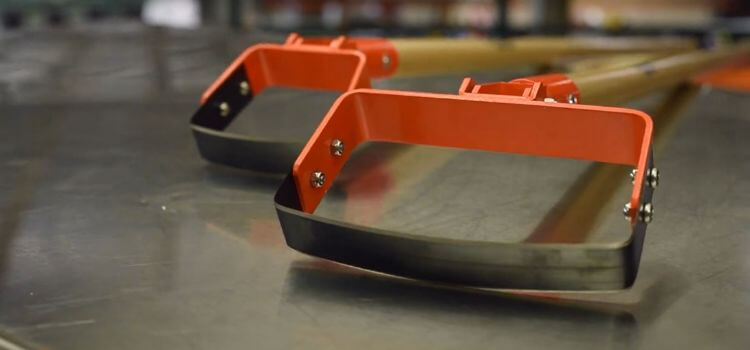As an Amazon Associate, I earn from qualifying purchases.
The stirrup hoe employs a push-pull action, whereas the Dutch hoe utilizes a forward slicing motion. Both are effective for weeding.
Gardeners often debate the best hoe for weeding. The stirrup hoe, known for its oscillating blade, excels at cutting weeds below the soil surface. Its push-pull action makes it efficient in loose soil. The Dutch hoe features a flat blade that slices through weeds with a forward motion, which is ideal for lighter, sandy soils.
Both tools have unique advantages and are designed to reduce the effort and time spent on weeding. Choosing between them depends on soil type, weed density, and personal preference. Understanding their differences helps gardeners maintain a weed-free garden more efficiently.
What Is A Stirrup Hoe?
A stirrup hoe is a gardening tool designed to remove weeds effortlessly. It features a unique oscillating blade that resembles a stirrup. The blade moves back and forth as you push and pull the hoe. My recommend stirrup hoe:
Walensee Mini Action Hoe – Stirrup Weeder
The Walensee Mini Action Hoe is designed for easy weeding and soil cultivation. Its 14-inch triangular stirrup head and sturdy metal blade make removing weeds simple, while the cushioned, ergonomic handle keeps your hand comfortable during long gardening sessions. The push-pull motion cuts through shallow roots efficiently, making your garden work faster and less tiring.
Why You Will Love This
- Triangular stirrup head for efficient weeding
- Ergonomic rubber handle reduces hand fatigue
- Durable, heat-treated steel blade
- Push-pull motion cuts weeds and shallow roots easily
Pros
- Lightweight yet strong for everyday gardening
- Ready to use straight out of the box
- Handles long weeding sessions comfortably
Cons
- Not suitable for very large or deep roots
- Metal blade may scratch if used on rocks
Picture cleaning up your flower beds on a sunny morning. You slide the Walensee hoe through stubborn weeds, and the triangular head grabs roots quickly. The cushioned handle feels soft but firm, so your hand doesn’t tire. Within minutes, your garden looks neat. Many gardeners say this tool saves them time and effort compared to traditional hand trowels.
Read Also: How to Use a Stirrup Hoe
What Is A Dutch Hoe?
Gardening tools have evolved, making gardening maintenance more accessible and efficient. The Stirrup Hoe and the Dutch Hoe are two popular tools in this regard. This post will delve into the specifics of the Dutch Hoe, providing a detailed understanding of its features, uses, and benefits. My recomend datch hoe:
Fiskars QuikFit Dutch Hoe – Tool Head
The Fiskars QuikFit Dutch Hoe is built for efficient weeding and soil cultivation. Its sharp Boron steel blade slices through weeds with ease, while the lacquered finish adds stability and long-lasting durability. The tool head fits all Fiskars QuikFit handles, giving you a customizable gardening experience. Lightweight yet strong, it makes pulling rows of seeds, moss removal, and general tillage less tiring and more precise.
Why You Will Love This
- Sharp Boron steel blade for efficient weeding
- Lacquered finish for extra stability and durability
- Fits all Fiskars QuikFit handles for versatility
- Lightweight design for easy handling
Pros
- Durable and long-lasting
- Precise weeding and soil work
- Easy to attach to different handles
Cons
- Tool head sold separately from handle
- Limited use without compatible handle
Imagine clearing a row of vegetables in your garden. The Fiskars Dutch Hoe glides through weeds, and its sharp blade reaches even shallow roots. You attach it to a QuikFit handle that feels comfortable in your hand, and suddenly, long weeding sessions are quicker and smoother. Many gardeners love how this tool lets them work efficiently without straining their back or arms, making garden maintenance a much easier task.
Walensee Mini Action Hoe vs Fiskars QuikFit Dutch Hoe – Detailed Comparison
Here’s a comparison table for the Walensee Mini Action Hoe and the Fiskars QuikFit Dutch Hoe, highlighting their key features:
| Feature | Walensee Mini Action Hoe | Fiskars QuikFit Dutch Hoe |
|---|---|---|
| Head Design | Triangular hollow stirrup head | Sharp ground weeding blade |
| Material | High-quality heat-treated steel | Hardened Boron steel |
| Handle | Ergonomic rubber handle | Compatible with QuikFit handles (sold separately) |
| Weight | Lightweight | Approximately 241g |
| Length | 14 inches | 12.5 cm (tool head only; handle sold separately) |
| Primary Use | Weeding, ditching, seeding, planting | Removing weeds, breaking up soil, creating seed rows |
| Grip | Cushioned, non-slip | Not applicable (tool head only) |
| Assembly Required | None | Requires QuikFit handle |
| Warranty | 100% satisfaction guarantee | Safety tested seal |
Frequently Asked Questions
A stirrup hoe is the best for weeding. It easily slices through weeds and is efficient for garden maintenance.
A stirrup hoe offers efficient weed removal. It cuts weeds at the root level. The tool minimizes soil disturbance. Users experience reduced physical strain. The hoe is ideal for tight spaces. It increases gardening productivity.
A stirrup hoe is used for weeding gardens and flower beds. It cuts weeds just below the soil surface, helping to maintain a clean garden efficiently.
Yes, a Dutch hoe is excellent for weeding. It slices through weeds at the soil surface efficiently, helping maintain garden beds and paths weed-free. Its long handle reduces back strain, making it user-friendly.
Conclusion
Choosing between a stirrup and a Dutch hoe depends on your gardening needs. Both tools offer unique benefits. The stirrup hoe is ideal for weeding, while the Dutch hoe excels at slicing through soil. Evaluate your garden’s specific requirements to make the best choice.
Happy gardening!



